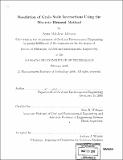| dc.contributor.advisor | John R. Williams. | en_US |
| dc.contributor.author | Johnson, Scott M. (Scott Matthew), 1978- | en_US |
| dc.contributor.other | Massachusetts Institute of Technology. Dept. of Civil and Environmental Engineering. | en_US |
| dc.date.accessioned | 2008-01-10T17:23:12Z | |
| dc.date.available | 2008-01-10T17:23:12Z | |
| dc.date.copyright | 2006 | en_US |
| dc.date.issued | 2006 | en_US |
| dc.identifier.uri | http://dspace.mit.edu/handle/1721.1/34375 | en_US |
| dc.identifier.uri | http://hdl.handle.net/1721.1/34375 | |
| dc.description | Thesis (Ph. D.)--Massachusetts Institute of Technology, Dept. of Civil and Environmental Engineering, 2006. | en_US |
| dc.description | Includes bibliographical references (p. 201-221). | en_US |
| dc.description.abstract | Granular materials are an integral part of many engineering systems. Currently, a popular tool for numerically investigating granular systems is the Discrete Element Method (DEM). Nearly all implementations of the DEM, however, use spheres to represent particles despite mounting evidence showing that shape at multiple scales (sphericity, angularity, and friction) plays a role in granular material behavior. This thesis contributes a new non-spherical representation to model particles as ellipsoidal bodies. This is validated and benchmarked against current representations and is shown to have attractive computational efficiency and numerical stability. A numerical study of the formation of heaps using spheres and ellipsoids both validates the ellipsoid representation and illustrates shape-induced behavioral differences. Resolution of shape is extended by a new algorithm for a hierarchical, multi-scale representation of convex particle surface characteristics. Two applications are offered: (1) a micro-asperity model is used to demonstrate pair-wise interlocking, and (2) a surface-based cohesive contact law is validated using a series of virtual numerical pull-off tests, which agree well with experimental findings. An explicit quadrature algorithm based on quaternion rotation is developed and shown to more accurately determine rotational orientation with less computational effort than other common algorithms for integrating finite rotations. | en_US |
| dc.description.abstract | (cont.) Finally, a contact resolution algorithm between discrete elements and a polyhedral boundary is developed and shown to scale in O(M + N) versus common algorithms with scaling of O(NM), where N is the number of discrete elements and M the number of faces on the polyhedral boundary. These developments are illustrated with numerical studies to simulate the blending kinetics of cohesive, micron-scale pharmaceutical powders in V-shaped and cylindrical bench-scale blenders. | en_US |
| dc.description.statementofresponsibility | by Scott Matthew Johnson. | en_US |
| dc.format.extent | 221 p. | en_US |
| dc.language.iso | eng | en_US |
| dc.publisher | Massachusetts Institute of Technology | en_US |
| dc.rights | M.I.T. theses are protected by copyright. They may be viewed from this source for any purpose, but reproduction or distribution in any format is prohibited without written permission. See provided URL for inquiries about permission. | en_US |
| dc.rights.uri | http://dspace.mit.edu/handle/1721.1/34375 | en_US |
| dc.rights.uri | http://dspace.mit.edu/handle/1721.1/7582 | |
| dc.subject | Civil and Environmental Engineering. | en_US |
| dc.title | Resolution of grain scale interactions using the Discrete Element Method | en_US |
| dc.type | Thesis | en_US |
| dc.description.degree | Ph.D. | en_US |
| dc.contributor.department | Massachusetts Institute of Technology. Department of Civil and Environmental Engineering | |
| dc.identifier.oclc | 70124937 | en_US |
